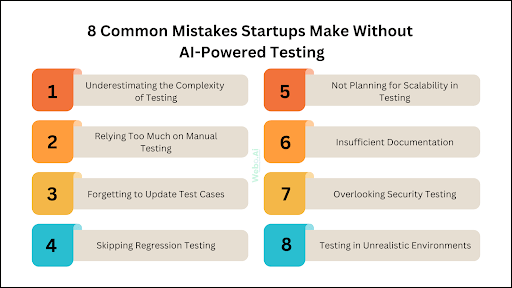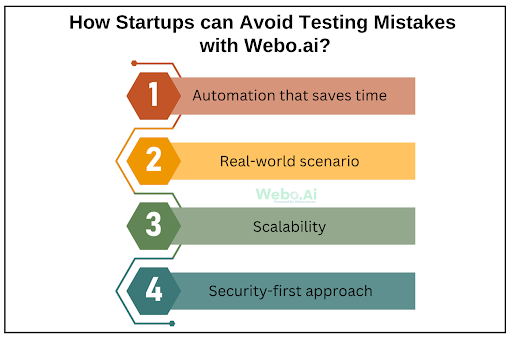8 Common Mistakes Startups Make Without AI-Powered Testing

Published on December 30, 2024
Introduction
Startups live in the fast lane. There’s pressure to innovate, scale, and make a mark before anyone even catches up. But let’s be honest—testing often feels like the annoying chore that slows everything down. And yet, skipping or mishandling it can spell disaster.
Many startups fumble testing, either because they don’t have the right tools or don’t realize how crucial it is. Let’s walk through eight all-too-common mistakes startups make when they don’t have AI-powered testing on their side.

1. Underestimating the Complexity of Testing
Testing sounds simple enough, right? Just make sure the app works. But as any seasoned developer will tell you, it’s a beast. Applications today are complex, with endless interactions and edge cases that aren’t always obvious.
Startups often assume they can manage more in less- maybe test a few features and call it a day. But here’s the catch: what seems fine in development often unravels when real users start clicking, swiping, and pushing your app to its limits. Bugs slip through, users get frustrated, and your brand’s reputation takes a nosedive.
2. Relying Too Much on Manual Testing
When you’re in the early stages, manual testing feels like the obvious choice. It’s hands-on, straightforward, and doesn’t require extra tools. But as your product grows, manual testing quickly turns into a bottleneck.
Think about it- how much time can your team really spend combing through every feature? And even if they try, human error is inevitable. It’s exhausting and, frankly, not scalable. Manual testing is fine as a starting point, but it’s no substitute for something faster and more reliable.
3. Forgetting to Update Test Cases
Here’s a scenario we’ve seen time and time again: a startup builds a test suite, feels pretty good about it, and then… forgets about it. Meanwhile, the product evolves, features change, and those old test cases? They’re about as useful as a broken compass.
When test cases aren’t updated, they miss bugs- or worse, give you a false sense of security. It’s like relying on outdated blueprints to build a skyscraper. Everything looks fine until the cracks start showing.
4. Skipping Regression Testing
Regression testing might sound like a chore, but trust me, it’s essential. Yet, startups often sideline it in favor of shiny new features. “We’ll check it later,” they say- until later becomes too late.
The thing is, every new update has the potential to break something that was working perfectly fine before. Without regression testing, you risk shipping a product that feels like one step forward, two steps back. And nothing frustrates users more than having a feature they love suddenly stop working.
5. Not Planning for Scalability in Testing
It’s easy to focus on the here and now, especially in a startup. But what happens when your user base grows from a handful to thousands- or even millions? Testing strategies that worked when you were small can’t keep up with that kind of growth.
I’ve seen startups scramble to adjust when their product starts scaling, and let me tell you, it’s not pretty. Bugs pile up, performance tanks and your team ends up in panic mode when they should be celebrating success.
6. Insufficient Documentation
Documentation often gets pushed to the side in software testing, especially when teams are under pressure to meet deadlines. However, neglecting this critical step can create a host of problems that affect the entire testing process.
Without proper test documentation, the analysis of testing efforts becomes flawed, limiting the testers’ ability to identify challenges and areas for improvement. Additionally, poor documentation leads to delayed feedback, making it harder to fix mistakes in time and impacting the quality of the final product. Apart from that, skipping documentation hampers internal coordination, as it limits knowledge sharing and reduces visibility into the testing process, which can ultimately diminish the product's quality.
7. Overlooking Security Testing
In the rush to launch, security testing often gets overlooked. It’s easy to think, “We’ll deal with it once we’ve got more users.” But by then, it might be too late.
Startups are prime targets for hackers, and even a minor breach can cause major damage. Lost data, angry users, and compliance headaches aren’t exactly the kind of buzz you want around your product. Security needs to be baked in from the start- not treated as an afterthought.
8. Testing in Unrealistic Environments
Here’s a common mistake: startups test their apps in perfect, controlled conditions. Clean networks, predictable inputs, and ideal devices. It’s all smooth sailing- until the app meets the messy reality of real-world users.
People use your product in ways you’d never imagine. They’re on spotty Wi-Fi, outdated devices, or switching between apps mid-task. If your testing environment doesn’t account for these variables, you’re setting yourself up for failure.
Turning Mistakes into Wins with Webo.ai
Let’s be real- making mistakes is part of the startup journey. But when it comes to testing, these missteps don’t have to be inevitable. That’s where Webomates can be a game-changer.
Webomates’ AI-powered testing platform - Webo.ai, is designed to tackle these challenges head-on. Think automated regression testing, real-world environment simulations, and test maintenance that keeps pace with your ever-changing codebase. It’s like having a safety net that grows with your product.
Here’s why Webo.ai stands out:

- Automation that saves time: No more manual testing bottlenecks.
- Real-world scenarios: Test your app the way your users actually use it.
- Scalability: Whether you’re serving 10 users or 10,000, we have got you covered.
- Security-first approach: Because trust matters.
Don’t wait for the bugs to find you. Take control with Webo.AI.
Ready to Level Up Your Testing?
Don’t let testing be the thing that holds your startup back. Take the leap with Webomates and see how AI-powered testing can transform your development process.
Try Webo.ai for free today and build a product your users will love- without the guesswork.
